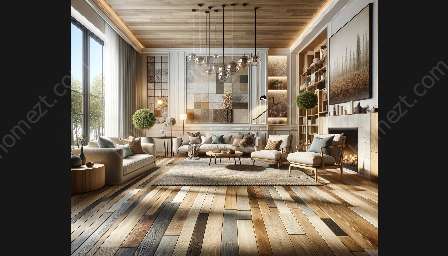When selecting flooring for high-traffic areas, it's crucial to consider factors such as durability, maintenance, aesthetic appeal, and the impact on interior design. Understanding how different flooring options fit into these considerations can help homeowners make informed decisions that will enhance the functionality and visual appeal of their living spaces.
Durability
One of the most important considerations when choosing flooring for high-traffic areas is durability. The selected flooring material should be able to withstand heavy foot traffic, frequent cleaning, and potential wear and tear without losing its visual appeal and structural integrity. Options such as laminate, vinyl, and ceramic tile are known for their durability and are well-suited for areas like hallways, entryways, and living rooms.
Maintenance
High-traffic areas require flooring that is easy to maintain. Homeowners should evaluate the maintenance requirements of different flooring options and choose materials that are resistant to stains, scratches, and spills. Additionally, the ease of cleaning and maintenance should be considered, as regular upkeep is essential to preserving the appearance and lifespan of the flooring. Hardwood, luxury vinyl plank, and porcelain tile are examples of low-maintenance flooring options ideal for high-traffic areas.
Aesthetic Appeal
While durability and maintenance are crucial, the aesthetic appeal of the flooring should not be overlooked. The chosen flooring should complement the overall interior design of the home and contribute to a cohesive, inviting atmosphere. Factors such as color, pattern, and texture should be carefully considered to ensure that the flooring enhances the visual appeal of the space. Hardwood, natural stone, and polished concrete are popular choices for high-traffic areas, offering both durability and aesthetic appeal.
Interior Design Impact
When selecting flooring for high-traffic areas, it's essential to consider the impact on the overall interior design of the home. The flooring material should align with the style and theme of the space, creating a harmonious transition from one area to another. For traditional or rustic interior designs, hardwood or natural stone flooring can add warmth and authenticity, while modern spaces may benefit from the sleek, minimalistic look of polished concrete or porcelain tile.
Environmental Considerations
For environmentally conscious homeowners, it's important to explore sustainable and eco-friendly flooring options. Materials such as bamboo, cork, and reclaimed wood offer sustainable alternatives that can withstand high-traffic areas while reducing the environmental impact. Understanding the eco-friendly attributes of different flooring materials can help homeowners make choices that align with their sustainability goals.
Cost and Budget
Finally, cost and budget play a significant role in choosing flooring options for high-traffic areas. Homeowners should consider the upfront cost of materials, installation, and long-term maintenance when making decisions. While hardwood and natural stone may have higher initial costs, their longevity and timeless appeal can make them cost-effective choices in the long run. On the other hand, affordable options like laminate and luxury vinyl plank provide durability and aesthetic value at a lower price point.
Conclusion
Choosing flooring for high-traffic areas involves a careful balance of durability, maintenance, aesthetic appeal, and the impact on interior design. By considering these essential factors, homeowners can select flooring options that not only withstand heavy foot traffic but also enhance the overall look and feel of their living spaces. Whether aiming for a classic, modern, or sustainable design, aligning flooring choices with the specific needs and style of the home is crucial for creating functional and visually appealing high-traffic areas.



